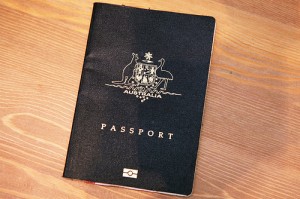How to Get an Australian Defacto Partner Visa
 In case you didn’t know, I am American, but I came to Australia because of a nice Aussie bloke I met over in Europe. When I arrived, I did the whole work and holiday visa thing, but the idea was always in the back of my mind that we needed to prepare for the partner visa if we wanted to continue living in the same country.
In case you didn’t know, I am American, but I came to Australia because of a nice Aussie bloke I met over in Europe. When I arrived, I did the whole work and holiday visa thing, but the idea was always in the back of my mind that we needed to prepare for the partner visa if we wanted to continue living in the same country.
Talk about relationship stress. I can’t imagine the situation for the couples that don’t even meet until one is already on a working holiday visa Down Under!
So, one year ago, we filled out all the forms and dropped them off at immigration in Sydney. Two weeks ago, I received my defacto partner visa (YAY!). If you’re doing the math, you will realize that took a good 11.5 months to receive (BOO!).
But, now that I have successfully acquired my partner visa, I thought I would share with you all the long and arduous process it takes to get one for yourself. Please remember that I am not immigration, so you should always check the official process before applying.
What is the Defacto Partner Visa?
 The defacto partner visa allows individuals to stay in Australia with their long-term, Australian boyfriend or girlfriend. When you apply, you are applying for both a temporary partner visa and permanent visa at the same time (good value for your money there), but the visa numbers you apply for depend on whether or not you are applying while inside or outside of Australia.
The defacto partner visa allows individuals to stay in Australia with their long-term, Australian boyfriend or girlfriend. When you apply, you are applying for both a temporary partner visa and permanent visa at the same time (good value for your money there), but the visa numbers you apply for depend on whether or not you are applying while inside or outside of Australia.
When inside Australia and applying for your defacto partner visa (like what I did), you will be applying for the subclass 820 and the subclass 801. When applying outside, you are applying for the subclass 309 and subclass 100. One thing to note is that wherever you apply is where immigration would like you to remain until a decision has been made on the application (so, you should plan to remain outside of the country the entire process if you apply overseas).
Once your application has been approved, you are typically able to work and travel freely, even applying for Medicare. After two years since the date you lodged the application, your partner status will be re-evaluated. If nothing has changed and immigration sees your relationship as genuine then you should receive your permanent visa for Australia!
Am I eligible for the defacto partner visa?

You also have to be 18 years of age and have a valid sponsor – one of Aussie citizenship or permanent residence, or a New Zealander. You must also pass health and security inspection.
How much does the defacto partner visa cost?
At the time of writing this post, applying for the visa outside of Australia will cost $1995, and applying inside Australia can run as high as $2960. See the official site for more information.
Please keep in mind this number does not factor in the cost of your medical exam (around $300) along with the security clearance checks you must receive.
Putting Together the Application
Putting the defacto partner visa application together is a very daunting process. Not only do you have to produce a lot of documentation on your end, but you also have to rely on the input of others – friends, family, doctors and police officials – to provide a complete application. Just remember to take it one step at a time.

Providing proof of the relationship: Your relationship must be pure and genuine, and the immigration agents must be able to see this. You and your sponsor (partner) will have to give a thorough timeline of the relationship, from how you met, how often you see each other, how you support each other (emotionally and financially) to where you see the future of your relationship. Provide photos that can be time-dated (when did you upload them to Facebook or Flickr?) and don’t forget about the power of emails. In the process, you might have to reveal a little bit of personal information, but it’s for your visa (and the money you paid in the process!).
Providing proof of the defacto relationship for 12 months: This is where it is good to show proof of joint bank accounts, joint apartment leases, that you have the same address on normal mail and that you make purchases together (or share in paying the bills).
Statutory declarations: Statutory declarations are forms that family members, mutual friends and friends will need to fill out on your behalf. Basically, these forms let immigration know that other individuals are aware of your relationship and can also tell how it is genuine.
Medical Exam: There is a series of medical tests one must pass in order to complete the application that include a chest x-ray and blood tests. You can get them all done in one day at a specified medical clinic that specializes in the exams for all types of visas. You can do this after you submit the official application and then take the sealed results to immigration to add to your packet.
Security/Police Checks: This gets a bit tricky, especially if you are currently in Australia. I had to get some background checks from the FBI in the USA, and to do that, I had to get fingerprinted in Australia – at the police station (headache finding a local one to do that!). Those were then sent to the USA, and the results were mailed back to me, sealed. You will need to check the requirements as living in many countries may result in you needing multiple checks.
As long as you pay, you can submit an incomplete application to immigration. Your application will not be complete, and cannot be considered for approval, until you have all items on the checklist crossed off (you can drop off the extra items as you go). Payment can be processed using a credit card, but if for some reason the payment does not clear, the application will be posted back to the applicant. I was phoned the following day as my credit card company blocked the transaction (it was for a huge expenditure in a foreign country), and I had to call the company to get that remedied so immigration could keep my app.
What happens once you apply?
When you apply and pay for your application, you are eligible for a bridging visa when lodging in Australia. The bridging visa allows you to remain in the country until your application’s decision has been made. So, once the current visa you are on runs out, the bridging visa becomes active.
Some things to note: You get the same working rights on the bridging visa as the visa you are on when applying. If you apply on a tourist visa, you therefore do not get any working rights during your process. There are also different types of bridging visas, and the main one does not allow an applicant to leave the country while waiting. If you do need to leave the country, then you will have to apply for a different class of bridging visa – and pay a fee.
The most important part of the application process:
 Having patience! It’s probably the hardest part as you will most likely go months without getting any update whatsoever. As stated in the intro, it took me 11.5 months of waiting to receive the approval.
Having patience! It’s probably the hardest part as you will most likely go months without getting any update whatsoever. As stated in the intro, it took me 11.5 months of waiting to receive the approval.
When a caseworker does finally pick up your case, he/she will contact you if you are missing any information, most likely by email. Sometimes, there is a need for interviews and additional documentation if they are in doubt.
I was lucky enough to had put together such a thorough application that no further information – besides the declarations they lost (keep backups!) – was needed before getting the big approval email.
If all goes well, you’ll get your visa and be on your way to getting PR (permanent residency). They evaluate that 2 years after the date of your lodgement, so I now have one more year to wait before that happens.
Oh, to love an Australian… 😉
If you haven’t fallen in love with an Australian, but are interested in making a move to Australia, have a read through some of the work visa options from which you can choose. Or, if you’re thinking the partner visa is the way to go, ladies, you can read this post on where to find a good Aussie bloke of your own. When you decide to take the next step, you might want to evaluate this list of places to honeymoon in Australia.
Photo credit: couple on beach, australia flag, approved